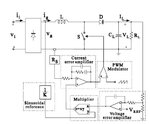AbhimanyuSingh
Member level 1
How does one obtain the reference current by measuring the output voltage of the Boost PFC converter. I assume that the load is unknown, ie changes with time. Or am I wrong? Why do I need to measure the output voltage to find reference current. Every book I have come across tells the procedure to find out the reference current. But no one explains the idea behind it. Or else there is something I am missing. But I havent understood how to calculate the constants and values to be multiplies with the measured output voltage to calculate the reference current. can someone help me with this? Or sugggest me a book or literature which can clarify this? Thanks in advance.
